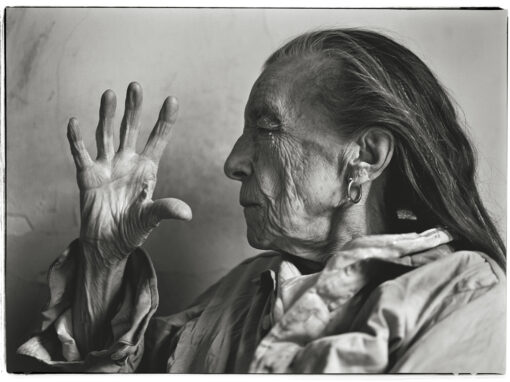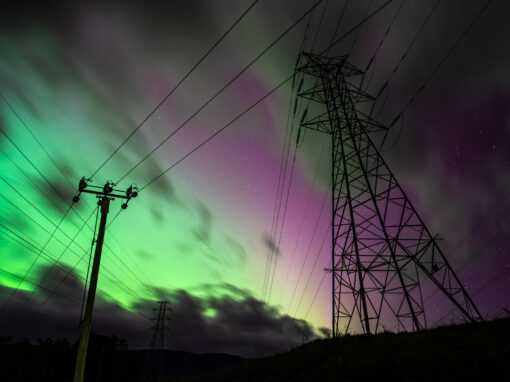This was captured at Death Valley. I’ve spent a great deal of time shooting in Death Valley. I find it a very inspirational place. But even more so at night as the dark sky and clear desert air allow very clear views of the heavens at night. I’ve hiked onto the dunes many times, mostly at first light in the early mornings. I decided I wanted a different take on the dunes and as I had been doing a great deal of night photography it seemed a logic thing to do.
With my preference for this sort of imagery to be in B&W, I prefer to shoot film for the night work, Fuji Acros, which has excellent reciprocity characteristics. I also prefer film because it filters out a great deal of the dimmer stars as I don’t want the sky to appear to be too busy. One criticism I have for a lot of the star imagery I have seen is that there’s just too much going on, because of the sheer number of stars and the often too long of an exposure. I prefer a nice graceful arc not a semi circle.
What I like about doing the night photography, besides the fact that it provides more opportunities is that it creates an interesting graphic element as well as an element of time and motion. One other thing I like, the opportunity aspect, is that for daylight B&W landscape you need great light and great clouds, and that doesn’t happen all that often. However there are more often clear night skies, at least where I shoot, than days with perfect light and clouds.
To do night sky work well you need to gain some understanding of astronomy, nothing too intense but you need some basic understanding. As an example, in the northern hemisphere when you face north the stars will circle around the north star. The arcs will curve up at the horizon, be almost vertical when you face east or west and will arc down at the horizon when you face south. It also helps to know something about where, when and how full a moon you can expect. Too little moonlight and the land goes very dark, too much moonlight and the sky is too bright and the land looks like it’s daylight.
The direction you’re shooting also matters, if you are shooting into the direction of the moon, you’ll likely lose the stars. If the moon is behind you the foreground might look flat lighted. I like a quarter moon that’s perpendicular to the direction I am shooting. Of course one needs to plan for this. One thing that can be either a nuisance or and interesting element are vehicles moving in your scene. When they are far away it can be interesting, if they are nearby they can ruin the light in the scene.
You’ll need a sturdy tripod, and what I do is hang sand bags from the tripod to cut down on the possibility of wind shaking the camera during exposure. The sand bags sit on the ground attached to the camera via bungee cords. I will also highlight certain areas of the ground scene with light painting. I use a very powerful and focused beam to paint the scene. I will usually stand well off to the side of the camera, sometimes 50 yards or more so that my light painting adds depth. Light painting for the camera’s position can give a flat look. This working away from the camera can create some issues as once I was photographing a scene “Dixon Cemetery” in which the camera was very close to a road that stood between the camera and the scene. Even though I was shooting at 2, 3, 4 o’clock in the morning there would still be the occasional vehicle on the road. I would have to run from my light painting spot to the camera and cover the lens so that the car headlights did not blow out the exposure. This resulted in the stars having a Morse Code effect of dots and dashes as I had to do this several times during many exposures.
On my website there are many night photos including two more of Death Valley at night.
What do you think are the TWO most impactful features that make your image a good photograph? Don’t be shy!
Well, this is a pretty simple image. I think the curves of the dunes and the way the dune peak breaks out from the foreground dune and the motion of the stars. It has mood as well.
If you would be able to make this photo once again, what would be the ONE thing you would like to do better or different?
First, I wouldn’t do this image again because I already did it and given the sheer simplicity of it there’s not a lot more that I could have done. Further when I make an image public, it usually means that I am done with it and there’s nothing else I would do to it. But if I could have at the time, I might have included more foreground. I cropped it either because the foreground had some flaws or was just the cropping that lens and format provided.
Brian Kosoff shared this photograph in the FRAMES Facebook Group.
Photographer
Brian Kosoff, Portland, Oregon, USA
Equipment and settings
Fotoman 612 camera, Fuji Acros film, I think a 180mm lens, probably f/11, 30 minute exposure. Some moonlight for the foreground and a fair amount of editing, cleaning up and also cropping the sides a bit. The negative was scanned at 4500 PPI on a Kodak IQSmart 3 scanner.





Carlos Ysunza
February 6, 2023 at 00:57
Great job my friend, the desert have so many opportunities for a creative good eye photographer like you… congrats
Thomas
February 17, 2023 at 12:03
Wonderful, minimalist picture! A great learning for me to shoot film to get rid of the mostly overhelming amount of stars in the picture. Thanks for sharing your work and thoughts.
Kevin
May 10, 2023 at 21:58
I never considered using B&W for night photography, but it works really well in this scene. Very strong, yet simple & minimalist image. Like others, I tend to go for “max detail” on my astro shots. This is an excellent alternative. Great work!